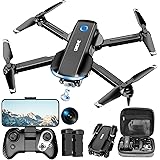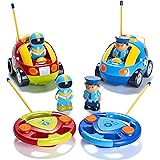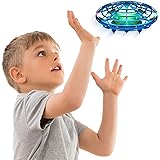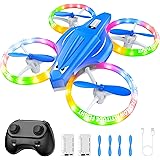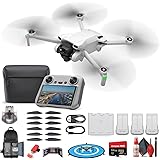Are you an RC plane enthusiast intrigued by the agility of multi-rotors, or perhaps a seasoned drone pilot seeking a truly distinctive addition to your fleet? The video above introduces a fascinating contender that masterfully bridges the gap between these two worlds: the FR Sky Rover 3 Tilt Rotor. This innovative aircraft, often dubbed a tricopter, offers a flight experience unlike any other on the market today, combining the best attributes of both traditional RC planes and modern FPV drones.
Unveiling the FR Sky Rover 3 Tilt Rotor: A Hybrid Marvel
The FR Sky Rover 3 Tilt Rotor stands out primarily due to its ingenious design, which incorporates tilt mechanisms on its two front rotors. This engineering marvel allows the aircraft to transition seamlessly between multi-rotor flight characteristics and those of a fixed-wing plane. Unlike conventional tricopters, where yaw control typically relies on a servo-driven rear motor, the Rover 3 leverages its tilting front motors for responsive yaw maneuvers, offering a fresh perspective on tricopter dynamics.
Furthermore, an often-overlooked yet highly practical feature of this multi-rotor is its integrated landing gear. While most drones are designed for hand launches or belly landings, the Rover 3 provides the capability for ground taxiing and engaging touch-and-go landings. This not only adds a layer of realism to the flight experience but also facilitates unique interactive scenarios, such as landing on various surfaces with precision and then effortlessly taking off again.
Advanced Flight Control with Betaflight Integration
At its core, the FR Sky Rover 3 operates on Betaflight, a highly customizable and widely adopted flight control software. This integration grants pilots extensive control over the aircraft’s flight characteristics, akin to any high-performance FPV quadcopter. Consequently, users can configure various flight modes, including Attitude Mode for stable, self-leveling flight, Horizon Mode for assisted acrobatics, and Angle Mode for a more forgiving experience, making it adaptable to different skill levels and flying styles.
The presence of a six-axis gyro further enhances the Rover 3’s stability and precision, ensuring a consistent and reliable flight performance across all configured modes. Betaflight’s flexibility means that pilots can fine-tune every aspect of the Rover 3’s behavior, from PID settings to arming procedures, optimizing it for their specific preferences and the unique demands of a tilt-rotor design. This level of programmability is a significant advantage for those who enjoy customizing their RC aircraft.
Integrated FPV and Robust Communication Systems
For an immersive flight experience, the FR Sky Rover 3 comes equipped with a front-mounted FPV camera. This feature allows pilots to fly as if they are seated in the cockpit, provided they have their own FPV goggles. A protective lens cover for the camera ensures its longevity, easily flipping down when in use and providing safeguarding during transport or storage, which is a thoughtful detail for active users.
Moreover, the video transmitter (VTX) within the Rover 3 is designed for versatility, supporting all common bands and featuring adjustable milliwatt output. This capability is crucial for group flying scenarios, enabling pilots to lower their power output (e.g., from 600 mW down to 25 mW) to prevent interference with other pilots. Additionally, FR Sky is renowned for its LUA scripts, and the Rover 3 supports this feature. Owners of the ready-to-fly kit can download these scripts directly from the FR Sky website and upload them to their compatible transmitters, streamlining the setup and configuration process considerably.
Impressive Endurance and Considered Design
One of the most noteworthy aspects of the FR Sky Rover 3 is its exceptional flight time. Utilizing a 3-cell 1300mAh battery, the aircraft can achieve approximately 11 to 12 minutes of flight, even when performing acrobatic maneuvers such as flips and rolls. This impressive endurance, achieved without sacrificing dynamic performance, truly sets the Rover 3 apart from many multi-rotors in its class, which often offer shorter flight durations.
Regarding battery compatibility, the Rover 3 is versatile, accommodating both 3-cell and 4-cell LiPo batteries ranging from 800mAh to 1300mAh. This flexibility allows pilots to choose between longer flight times (with 3S) or more aggressive performance (with 4S). The aircraft itself weighs 220 grams without a battery, a specification relevant for enthusiasts in regions with strict drone weight regulations (e.g., 250 grams). While its lightweight construction contributes to its agility and flight time, it also suggests that while the Rover 3 can withstand minor bumps, severe crashes might necessitate replacement of its plastic components, a common trade-off in many high-performance hobby aircraft.
Versatility in Control: Transmitter Options
The ready-to-fly package of the FR Sky Rover 3 typically includes the X-Lite transmitter, which boasts a form factor reminiscent of a gaming controller. This design can be particularly appealing to individuals who are accustomed to gaming and prefer a “thumbing” style of control. Nevertheless, the Rover 3 is not limited to a single transmitter; it is compatible with a wide array of FR Sky transmitters, such as the popular Taranis X9D, offering pilots the freedom to use their preferred control device.
Crucially, the Rover 3 features a flight controller with a built-in receiver. This integrated design not only simplifies the internal wiring but also provides a significant benefit for future upgrades or repairs. Should a pilot decide to transition to a different drone or need to replace components, the flight controller can be repurposed for virtually any other multi-rotor project, highlighting the modularity and long-term value inherent in the FR Sky Rover 3 Tilt Rotor.
Who is the Rover 3 For? Bridging the RC Divide
When considering the ideal pilot for the FR Sky Rover 3 Tilt Rotor, it becomes apparent that this aircraft serves a unique niche. It is an exemplary choice for pilots accustomed to traditional RC airplanes who wish to explore the world of multi-rotors without fully committing to a conventional quadcopter setup. The tilt-rotor mechanism offers a familiar “airplane feel,” making the transition more intuitive and less intimidating for plane enthusiasts.
Conversely, for experienced multi-rotor pilots seeking an unconventional flying experience, the Rover 3 provides a fresh challenge and a distinct flavor of aerial dynamics. Its hybrid capabilities mean it can perform tasks that neither a standard drone nor an airplane can accomplish with the same fluidity, making it a compelling addition to any diverse RC collection. Ultimately, the FR Sky Rover 3 Tilt Rotor represents an exciting evolution in hobby RC aircraft, offering unparalleled versatility and enjoyment to a broad spectrum of enthusiasts.


